Results 4,921 to 4,930 of 12094
Thread: Anandtech News
-
04-20-15, 07:06 AM #4921
Anandtech: Intel NUC5i7RYH Broadwell-U Iris NUC Review
Over the last couple of years, mini-PCs in the ultra-compact form factor (UCFF) have emerged as one of the bright spots in the troubled PC market. Intel's NUC systems are one of the most popular in this category. The lack of graphic prowess in the NUCs allowed for machines such as BRIX Pro (based on the Haswell Iris Pro CPU) to enter the market. With Broadwell, Intel is bringing out an Iris NUC on its own. Read on for our review of the NUC5i7RYH.
More...
-
04-20-15, 03:30 PM #4922
Anandtech: Samsung Introduces New 8" and 9.7" Galaxy Tab A Tablets
Today Samsung Electronics America announced two new tablets that are coming to market in the United States. Samsung's new Galaxy Tab A tablets come in 8.0" and 9.7" sizes, and Samsung is marketing them as tablets that are well suited for keeping in touch with friends and family. The specs of both tablets are laid out in the chart below.
Both tablets have very similar specifications. They are both distinctly mid-range tablets, with Qualcomm's Snapdragon 410 at their heart, 1.5GB of RAM, and a 1024x768 PLS display. They're really only differentiated by the size of their displays, and subsequently their dimensions and battery capacity. I think it may be difficult for Samsung to charge a price premium for the 9.7" model when it doesn't have any improvements to display resolution or internal hardware over the 8.0" model.Samsung Galaxy Tab A 8.0" Samsung Galaxy Tab A 9.7"SoC Snapdragon 410 (APQ8016) 4x 1.2GHz Cortex A53,
400MHz Adreno 306 GPURAM/NAND 16/32GB NAND + MicroSDXC, 1.5GB RAM Display 8.0" 1024x768 PLS LCD 9.7" 1024x768 PLS LCD Dimensions 208.4 x 137.9 x 7.5mm, 313g 242.5 x 166.8 x 7.5mm, 449g Camera 5MP Rear Facing, 2MP Front Facing Battery 4200 mAh (15.96 Whr) 6000 mAh (22.8 Whr) OS Android 5.0 Lollipop Connectivity 802.11 a/b/g/n + BT 4.0, microUSB2.0
What makes these new tablets stand out from Samsung's previous tablet offerings are their sizes and their design. Both tablets have a 4:3 aspect ratio, which is a significant departure from the 16:10 tablets that Samsung has produced in the past. Both tablets also have a full metal chassis, which will be an enormous improvement over the plastic construction of Samsung's other tablets. I am very interested to see what Samsung can do with this type of design on a high end tablet with flagship specifications.
Both Galaxy Tab A models are available for preorder now, and they'll begin to ship on May 1st in the United States. Both models are available in white, titanium, and blue finishes. The 8.0" model costs at $229, while the 9.7" model costs $299. There will also be a version of the 9.7" model with Samsung's S-pen included for $349. Through Samsung's new app partnership with Microsoft, the new tablets will come with Microsoft's Office for Android applications preinstalled, and buyers will receive 100GB of OneDrive storage for two years.
More...
-
04-21-15, 08:04 AM #4923
Anandtech: The Moto E (2015) Review
During the past couple of years we've seen a dramatic shift in Motorola's strategy for competing in the smartphone market. As one of the earliest producers of Android devices, the company needed to let go of ideas and strategies from years that had since past. Producing exclusive devices for carriers like Verizon was no longer going to work with the iPhone finally freed from exclusivity on AT&T, and Motorola's hardware and software design had begun to show a great deal of age.
That brings us to today, at a point where Motorola has more or less found their new approach to making smartphones. It's a very simple and understandable approach. Consistency across the design of the hardware, consistency across the design of the software, and a yearly line of phones that can easily be divided into budget, mid-range, and flagship categories based on a single letter in their name. This review takes a look at the newest version of Motorola's budget device, the 2015 Moto E. Read on for our full review of Motorola's newest smartphone.
More...
-
04-22-15, 10:31 AM #4924
Anandtech: Intel PPSTCK1A32WFC Bay Trail-T Compute Stick Review
The success of UCFF PCs have made vendors realize that small and power-efficient computing platforms are here to stay. ARM SoC manufacturers, finding that the tablet market had reached saturation, kick-started a new product category in the form of 'HDMI sticks'. As a computing platform, they were smaller than the ultra-compact form factor PCs - just looking like an oversized USB key. Intel announced the Compute Stick at CES to bring one of the first Wintel platforms into this space. Late last month, Google also introduced a Chrome OS-based HDMI stick. Both of these point to the 'stick' computing platform being more than just a passing fad. The Intel Compute Stick we are reviewing today comes with Windows 8.1 with Bing (32-bit) pre-installed, making it ready to roll right out of the box. Read on for a performance review and our thoughts on the product.
More...
-
04-22-15, 02:00 PM #4925
Anandtech: Google Unveils Project Fi: A Network for the Nexus 6
Today Google officially announced their previously rumored entry into the world of wireless service. This new endeavor is known as Project Fi, and it's exclusive to owners of the Nexus 6 who live in the United States. While carriers have offered branded mobile devices at times, the entry of a company making mobile phones into the business of providing the wireless service for their own devices is unprecedented. But unlike Google Fiber, Project Fi is not Google's attempt to build a new wireless network in the United States. Rather, they will be acting as a Mobile Virtual Network Operator (MVNO) running on the T-Mobile and Sprint networks, as well as piggybacking off of open WiFi hotspots.
On a typical carrier you will pay for some bucket of data alongside your calling minutes and texts, and if you don't use all that data during the month then it disappears. Some carriers like T-Mobile USA have played with this by allowing data to roll over to another month, much like how many prepaid carriers allow minutes to roll over to the next month if they are unused. But in general, you often end up paying for more data then you actually need to avoid overage charges. With Project Fi, Google starts plans at $20 per month for unlimited domestic calling and unlimited domestic + international texting. On top of that you can select how much data you believe you will need, with the cost being $10/GB.
The unique aspect of Project Fi when compared to other network operators is how Google is changing the situation with unused data. Rather than rolling it over or having it disappear, Google simply credits you for the difference. For example, a user who pays $30 for 3GB per month may only use 1.4GB that month. In that situation, Google will credit them $16 for the data they did not use. Effectively, this means that Google only charges users for the data they use, but not at the typically ridiculous rates for pay as you need data on other carriers. What I don't understand is why Google even has data tiers in the first place. Given the rounding, they might as well just charge $1 for every 100MB used, as any overages are charged as the same rate as the data in the plan itself.
Google is also taking much of the pain out of roaming in other nations. The data you purchase for your Project Fi plan is usable in 120 different countries, although it's limited to a speed of 256Kbps. Google's network also extends beyond cellular carriers, with Google's network configured to automatically utilize public hotspots as part of the network itself. WiFi calling is supported, and so the transition between cellular and WiFi should be seamless in theory. Google is also promising that information will be encrypted so that users can have their privacy preserved when using public WiFi.
The last really interesting part of Project Fi is how it will be able to integrate with Hangouts. Since your phone number "lives in the cloud", Google can push texts and phone calls to any devices that have the Google Hangouts application installed. This extends from your Nexus 6, to your Chromebook, to your iPad, to your Windows PC.
Project Fi is currently beginning as an early access program. Users who are interested and who own the Nexus 6 can check out Google's sign up page to apply to be one of the first users of this new network. Google's blog post in the source below has a bit more information as well as a video about this new project
More...
-
04-22-15, 07:00 PM #4926
Anandtech: Qualcomm Reports FY 2015 Q2 Results: Strong Q2 But Lower Forecast For 2015
Qualcomm released their Q2 financial results today, and they had another strong quarter. Revenues increased 8% from Q2 2014, coming in at $6.9 billion. On a GAAP basis, operating Income took a nose dive to $1.3 billion, down from $2.0 billion last year and $2.1 billion last quarter. This of course means that net income is also much lower, with $1.1 billion being reported for Q2 2015, which is down 46% from last year and 47% from last quarter. GAAP earnings per share came in at $0.63, down from $1.14 last year and $1.17 last quarter.
The reason for the large hit to operating income, net income, and EPS is due to Qualcomm having to pay out $975 million to the China National Development and Reform Commission or NDRC. This charge is the resolution that was enacted due to Qualcomm falling afoul of China’s Anti-Monopoly Law, and as such it is a one-time fee. As such, Qualcomm has also released Non-GAAP results which exclude this one time hit to get a better look at how the business is operating. On a Non-GAAP basis, operating income was up 16% year-over-year to $2.7 billion, which is also a 7% gain over last quarter. Net income was up 4% at $2.3 billion, and EPS came in at $1.40 for Q2, as compared to $1.31 last year and $1.34 last quarter.Qualcomm Q2 2015 Financial Results (GAAP) Q2'2015 Q1'2015 Q2'2014 Revenue $6.894B $7.099B $6.367B Gross Margin 19.4% 29.1% 31.3% Operating Income $1.336B $2.064B $1.990B Net Income $1.053B $1.972B $1.959B Earnings Per Share $0.63 $1.17 $1.31
Qualcomm actually had negative cash flow for the quarter. The already mentioned fine paid to China accounted for some of it, and Qualcomm also performed a prepayment of $950 million to secure long-term capacity from one of their suppliers. Those two hits resulted in a $0.7 billion shortfall in cash flow. Last year, they had $1.8 billion in positive cash flow, and last quarter it was $2.4 billion.Qualcomm Q2 2015 Financial Results (Non-GAAP) Q2'2015 Q1'2015 Q2'2014 Revenue $6.894B $7.099B $6.367B Gross Margin 39.3% 35.7% 36.7% Operating Income $2.707B $2.531B $2.337B Net Income $2.339B $2.263B $2.255B Earnings Per Share $1.40 $1.34 $1.31
For the second quarter, Qualcomm shipped 233 million MSM chips, which is up 24% year-over-year, but down from the 270 million shipped in Q1. Total device sales from Qualcomm licencees was $75.8 billion for the quarter, up 14% year-over-year and up 34% quarter-over-quarter. The company is estimating that 384-388 million 3G/4G devices shipped in Q2, which is up 30% over Q2 2014 and up 35% over Q1 2015. Average Selling Price of 3G/4G devices was $193-$199, which is down 13% year-over-year and 1% from last quarter, as the market moves towards lower cost devices.
Qualcomm repurchased 27.8 million shares in Q2, plus paid out $0.42 per share, returning $2.6 billion to shareholders of the company. On March 9th, they announced a new $15 billion stock repurchasing program which includes $10 billion in shares to be bought back in the next twelve months. Additionally, they will be paying out $0.48 per share on June 24th to any shareholder of record as of June 3rd, which is 14% more than last quarter’s payout.Qualcomm Devices Q2'2015 Q1'2015 Q2'2014 MSM Chip Shipments 233M 270M 188M Total Reported Device Sales $75.8B $56.4B $66.5B Est. reported 3G/4G device shipments 384-388M 284-288M 295-299M 3G/4G Device Average Selling Price $193-$199 $194-$200 $221-$227
However not everything to come out of the results was good news. Qualcomm has lowered their outlook for the semiconductor business for the second half of FY 2015. Greater competition has reduced Qualcomm’s market share in the SoC space, especially within flagship phones. The two largest phone makers, Samsung and Apple, both use their own designs in their flagship products. This will change Qualcomm’s product mix more heavily towards modem chipsets. There has also been some uncertainly created due to the existing licensing agreements Qualcomm has in place in China due to the resolution with the NDRC. With the case now concluded, the company is hopeful that these arrangements can be sorted out, as they believe that not all devices sold in calendar year 2014 were reported to them.
For Q3, the estimate is that revenues will decline by 9-21% over Q3 2014, which will drop EPS 31% to 41% on a Non-GAAP basis, or 37% to 49% based on GAAP reporting. For FY 2015, Qualcomm is estimating revenue to be between negative 6% and positive 2%.
Source: Qualcomm
More...
-
04-23-15, 07:30 AM #4927
Anandtech: The Gigabyte P35X v3 Review: Slim GTX980M Gaming Laptop
Gigabyte has refreshed its P35 series to include the latest NVIDIA GPUs, and the P35X is the top model in their 15.6 inch lineup. Gigabyte has the lightest GTX980M gaming laptop available, with the P35X v3 coming in at just 2.3 kg (5.07 lbs) thanks to the all-aluminum chassis. At just 20.9 mm (0.82”) thick, it is a fairly portable laptop considering the components inside.
More...
-
04-23-15, 07:30 AM #4928
Anandtech: Android Wear Updates: Wi-Fi, Always-On Apps and Usability
This week Google announced the latest update to their smart watch focused operating system, Android Wear. Google did not specify the exact version number, but the previous version was 1.0.5 and each release has bumped the last digit, so best guess is this is version 1.0.6. This update adds three main features: Wi-Fi support, Always-On application support, and several welcome usability upgrades.
The most significant feature from a technical and business standpoint is the addition of Wi-Fi support. Although it is not clear which (if any) existing Android Wear devices have Wi-Fi hardware to take advantage of software Wi-Fi support, this will absolutely help Google attract device manufacturers to deploy Android Wear instead of something custom such as Tizen or otherwise. As device manufactures deploying Android Wear can only differentiate themselves via hardware, continued hardware feature additions by Google become important. For example, a new Android Wear device launching with this update could possibly boast a first-with-Wi-Fi title. We should expect to see this continue for other presently missing major features such as LTE and camera.
As for the Wi-Fi experience, Google is not exactly clear. Their description of the feature's utility is in one sentence: "As long as your watch is connected to a Wi-Fi network, and your phone has a data connection (wherever it is), you’ll be able to get notifications, send messages, and use all your favorite apps." This description hints that Google is using a cloud service to connect the phone and watch together, therefore eliminating the device to device range aspects of Bluetooth pairing. This is both more and less than expected. I personally love the idea of using Wi-Fi as a range extender, as I often walk away from my desk and leave my phone far behind only to notice later when my watch complains of no connection. However, I would have also expected Wi-Fi to be exposed to apps somehow for watch-to-thing type interactions. For example, pressing a button on the watch to change the channel on a Kodi media center. That may still be possible with this update- Google simply has not provided details yet.
Also in this update is a new feature for applications: Always-On. Previously, all Android Wear applications were subject to a timeout and developers were advised not to rely on continuous screen time. In fact, the developer's guide still contains this now-outdated information. Always-On allows an application which is in full-screen-mode (not simply showing a Google Now banner) to register for permanent display. This pardons the app from the shutdown timeout and therefore keeps it front and center even after the wearer lowers their arm. As Android Wear always returns to the watch face when an app times out, this can save a considerable amount of navigation if the wearer is repeatedly pulling up the same app during an activity such as checking a shopping list. Google has retained the wrist raise-and-twist detection to detect if the wearer is actively looking at the display, and will turn the display black and white if it determines the watch has been lowered from view. Google claims this saves battery life, but in practice this is really only going to be the case for OLED based devices, as the power savings on a LCD based device are going to be minimal (maybe a slight reduction in backlight intensity).
With regards to usability updates, Google has added a new gesture to scroll through notifications via wrist twisting. This allows a wearer to view details without reaching over with the other hand to touch the display, to aid in situations where the wearer's hands are full. I am personally excited about this update as it was often faster to reach into my pocket with the other hand and retrieve my phone than it was to touch the watch display. The smart watch still had utility if I was not near my phone or my hands were both free, but this update should expand its utility farther.
Google has also resolved the absolutely bizarre way that apps had to be launched in the previous versions of Android Wear. From the watch face, the wearer had to tap the screen, scroll to the bottom of a very long list of actions and select the ambiguous "Start..." action to then be presented with the application list. This was far from intuitive. In this update, apps, contacts, and that long list of actions are surfaced in a single sliding pane behind a single tap of the watch face.
Google has also (finally!) added the ability to ask the watch to find the paired phone. Google has not yet described how this feature works, but I am thankful this obvious feature has arrived. It is quite silly, but I often find myself receiving many notifications and have no idea where my phone is- resulting in a frantic search while my wrist continues to vibrate.
Finally, Google has added the ability to reply to messages with a drawn emoji. Presently, this seems impossible to execute well on such a small screen so I look forward to testing this myself. The example Google provides is below, and seems completely implausible unless people are better finger artists than I would expect.
The update is being deployed over the next several weeks to all Android Wear devices, starting with the LG Watch Urbane. The Moto 360 I am using has not yet received the update.
More...
-
04-23-15, 08:30 AM #4929
Anandtech: Patriot Supersonic Rage 2 USB 3.0 256GB Flash Drive Capsule Review
The rise of USB 3.0 as a high speed interface for PCs and the increasing affordability of flash memory has led to some very interesting products. USB flash drives are a dime a dozen, but there is scope for manufacturers to differentiate themselves. High-performance flash drives have traditionally employed a SATA SSD controller behind a USB 3.0 - SATA bridge. However, this increases the drive cost in what is essentially a price-sensitive market. Controller vendors have recently started to introduce native high-performance USB 3.0 flash controllers. Today, we will be looking at the performance of the Patriot Supersonic Rage 2 256GB, a high-end USB 3.0 flash drive sporting a recently introduced native USB 3.0 flash controller.
The list of flash drives used for comparison purposes in this review is provided below.
- Patriot Supersonic Rage 2 256GB
- Corsair Voyager GTX 256GB
- VisionTek Pocket SSD 240GB
Hardware Design and Internals
In terms of external design and features, the Patriot Supersonic Rage 2 doesn't depart from the older members in its lineup. It still features a retractable USB connector, allowing for a compact design. There is also no need for an explicit cap on the USB connector. The design also supports hanging the flash drive off a keychain. As we can see from the photograph below, the Supersonic Rage 2 256GB is the smallest flash drive that we have evaluated in its capacity class.
Without opening up the unit, it is possible to identify the controller and flash inside the unit.
We see that the Supersonic Rage 2 uses the Phison PS2251-08 controller with firmware version 5.00.10. The controller was introduced at CES earlier this year. The drive uses Toshiba MLC NAND.
Testbed Setup and Testing Methodology
Evaluation of DAS units on Windows is done with the testbed outlined in the table below. For devices with USB 3.0 connections (such as the Patriot Supersonic Rage 2 that we are considering today), we utilize the USB 3.0 port directly hanging off the PCH. This port supports UASP, even though the drive we are considering today doesn't advertise support for it.
The full details of the reasoning behind choosing the above build components can be found here.AnandTech DAS Testbed Configuration Motherboard Asus Z97-PRO Wi-Fi ac ATX CPU Intel Core i7-4790 Memory Corsair Vengeance Pro CMY32GX3M4A2133C11
32 GB (4x 8GB)
DDR3-2133 @ 11-11-11-27OS Drive Seagate 600 Pro 400 GB Optical Drive Asus BW-16D1HT 16x Blu-ray Write (w/ M-Disc Support) Add-on Card Asus Thunderbolt EX II Chassis Corsair Air 540 PSU Corsair AX760i 760 W OS Windows 8.1 Pro Thanks to Asus and Corsair for the build components
Synthetic Benchmarks - ATTO and Crystal DiskMark
Patriot claims read and write speeds of 400 MBps and 300 MBps respectively. These might be achievable in specific benchmark modes with appropriate queue depths, but they are not backed up by the ATTO benchmarks provided below. That said, these access traces are not very common in real-life scenarios.
CrystalDiskMark, despite being a canned benchmark, provides a better estimate of the performance range with a selected set of numbers. As evident from the screenshot below, the performance can dip to the KBps range for 4K random acceses.
Benchmarks - robocopy and PCMark 8 Storage Bench
Our testing methodology for DAS units also takes into consideration the usual use-case for such devices. The most common usage scenario is transfer of large amounts of photos and videos to and from the unit. The minor usage scenario is importing files directly off the DAS into a multimedia editing program such as Adobe Photoshop.
In order to tackle the first use-case, we created three test folders with the following characteristics:
- Photos: 15.6 GB collection of 4320 photos (RAW as well as JPEGs) in 61 sub-folders
- Videos: 16.1 GB collection of 244 videos (MP4 as well as MOVs) in 6 sub-folders
- BR: 10.7 GB Blu-ray folder structure of the IDT Benchmark Blu-ray (the same that we use in our robocopy tests for NAS systems)





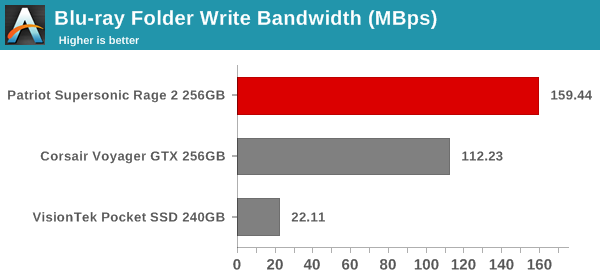
In the above use-cases, the Supersonic Rage 2 manages to acquit itself very well. It comes out on top in the majority of the benchmarks.
For the second use-case, we take advantage of PC Mark 8's storage bench. The storage workload involves games as well as multimedia editing applications. The command line version allows us to cherry-pick storage traces to run on a target drive. We chose the following traces.
- Adobe Photoshop (Light)
- Adobe Photoshop (Heavy)
- Adobe After Effects
- Adobe Illustrator
Usually, PC Mark 8 reports time to complete the trace, but the detailed log report has the read and write bandwidth figures which we present in our performance graphs. Note that the bandwidth number reported in the results don't involve idle time compression. Results might appear low, but that is part of the workload characteristic. Note that the same testbed is being used for all DAS units. Therefore, comparing the numbers for each trace should be possible across different DAS units.
Units sporting a SATA SSD controller tend to perform very well in this benchmark. Drives such as the Supersonic Rage 2 do not target the market for portable SSDs.


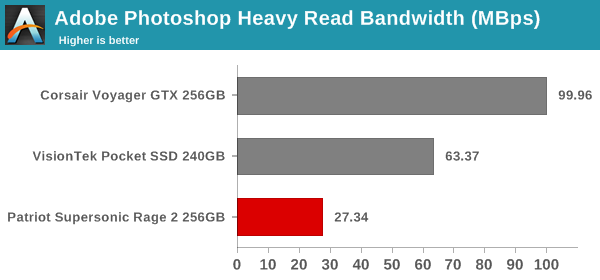

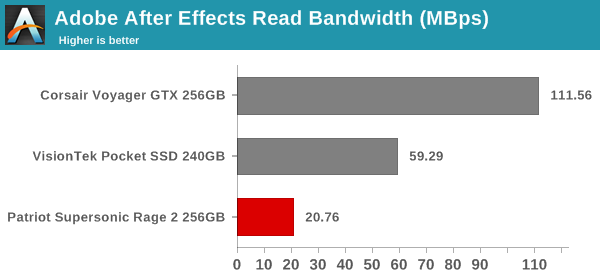
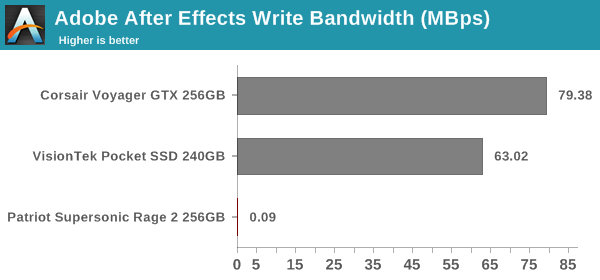


Performance Consistency
Yet another interesting aspect of these types of units is performance consistency. Aspects that may influence this include thermal throttling and firmware caps on access rates to avoid overheating or other similar scenarios. This aspect is an important one, as the last thing that users want to see when copying over, say, 100 GB of data to the flash drive, is the transfer rate going to USB 2.0 speeds. In order to identify whether the drive under test suffers from this problem, we instrumented our robocopy DAS benchmark suite to record the flash drive's read and write transfer rates while the robocopy process took place in the background. For supported drives, we also recorded the internal temperature of the drive during the process (unfortunately, not for the Supersonic Rage 2). The graphs below show the speeds observed during our real-world DAS suite processing. The first three sets of writes and reads correspond to the photos suite. A small gap (for the transfer of the videos suite from the primary drive to the RAM drive) is followed by three sets for the next data set. Another small RAM-drive transfer gap is followed by three sets for the Blu-ray folder.
An important point to note here is that each of the first three blue and green areas correspond to 15.6 GB of writes and reads respectively. Throttling, if any, is apparent within the processing of the photos suite itself.
We find that the unit doesn't suffer from any throttling issues, with transfer rates being quite consistent after the initial startup phase.
Concluding Remarks
Coming to the business end of the review, the Supersonic Rage 2 continues Patriot's tradition of improving the performance of their USB 3.0 flash drive every year. This time around, they have been helped by Phison's new high-performance native USB 3.0 flash controller. While SATA SSD controllers enable features such as TRIM and over-provisioning control (such as what we saw in the Corsair Voyager GTX), they are not user-controllable in devices with native USB 3.0 controllers.
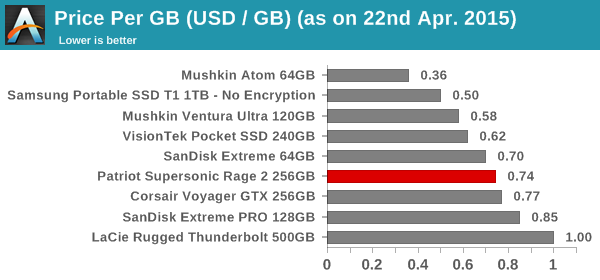
A typical 256 GB SSD in a 2.5" bus-powered USB 3.0 enclosure retails for around $125. The Patriot Supersonic Rage 2 256GB has a current street price of $190 on Amazon. The form factor of the USB drive carries a premium. Compared to flash drives in its capacity class, the Rage 2 is cheaper than the Corsair Voyager GTX, thanks to doing away with the USB 3.0 - SATA bridge. However, it is priced higher than the VisionTek Pocket SSD based on a SandForce SF-2281 SATA SSD controller. Then, again, the Rage 2 doesn't suffer from the thermal throttling issues that plague the VisionTek unit.
Coming to the business end of the review, the Supersonic Rage 2 makes for a great flash drive (decent write speeds and very fast reads for large-sized files, but mediocre random access speeds). It is also the smallest and most compact 256GB flash drive that we have evaluated so far. Users should not mistake it for a portable SSD and, to Patriot's credit, they don't advertise it as one.
More...
-
Thread Information
Users Browsing this Thread
There are currently 18 users browsing this thread. (0 members and 18 guests)





 Quote
Quote
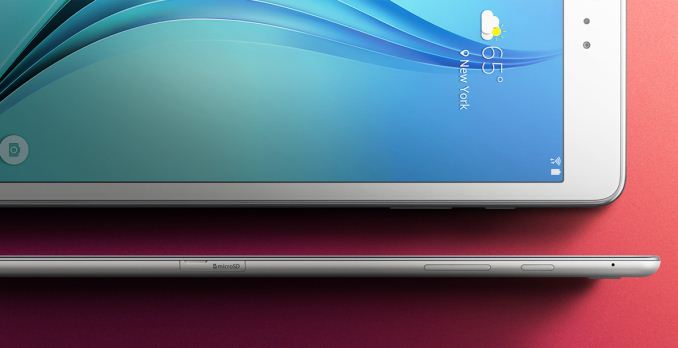
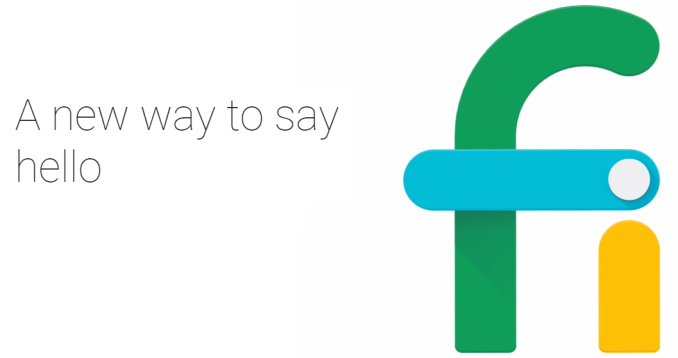

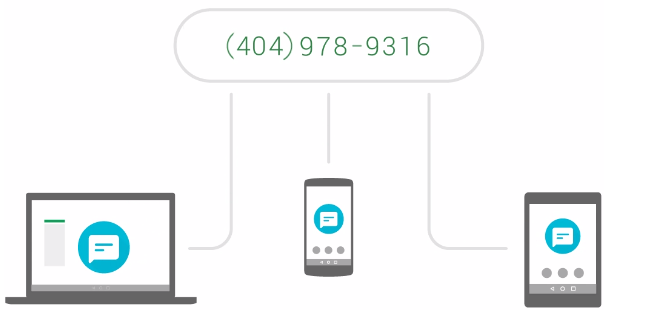

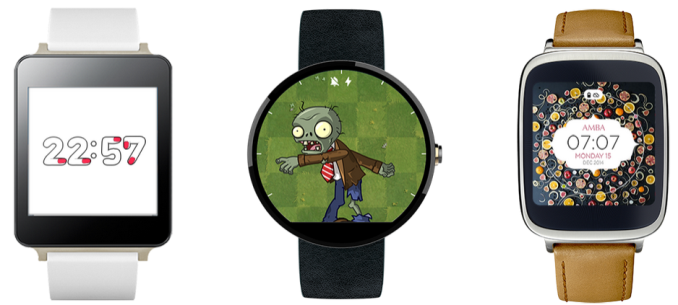
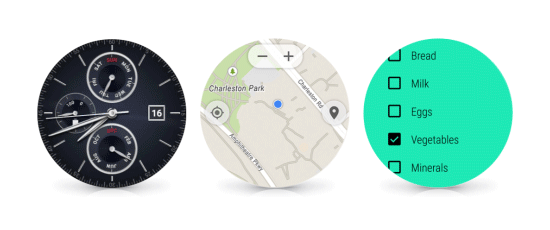
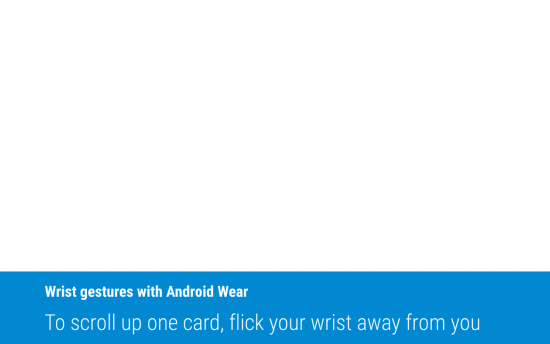
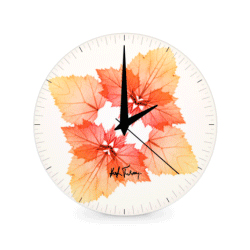


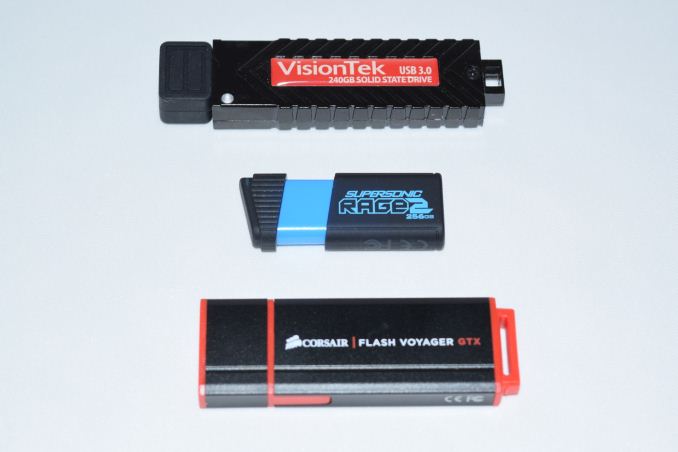
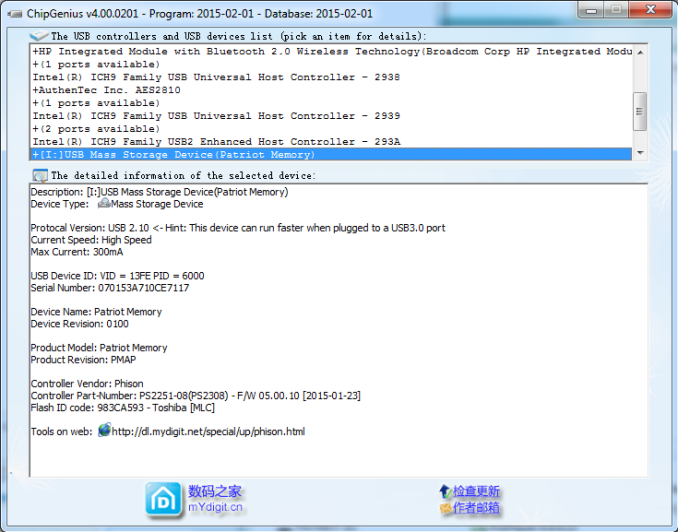
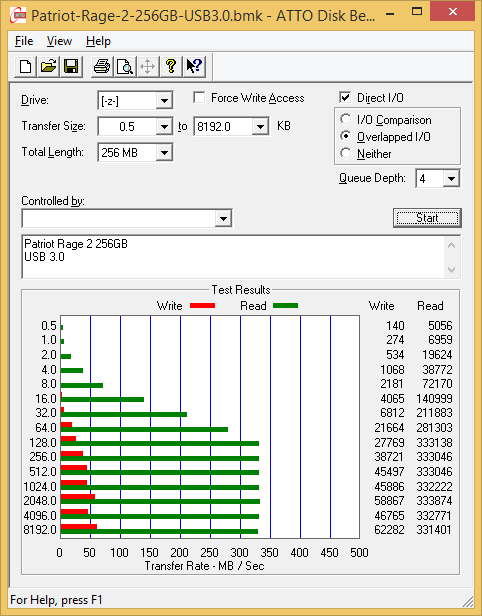
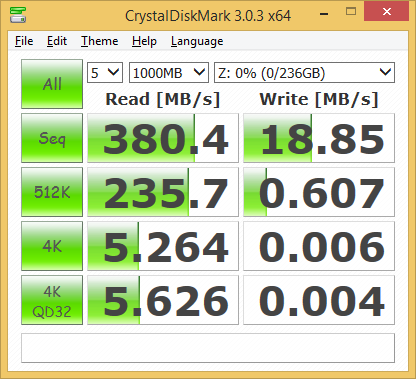
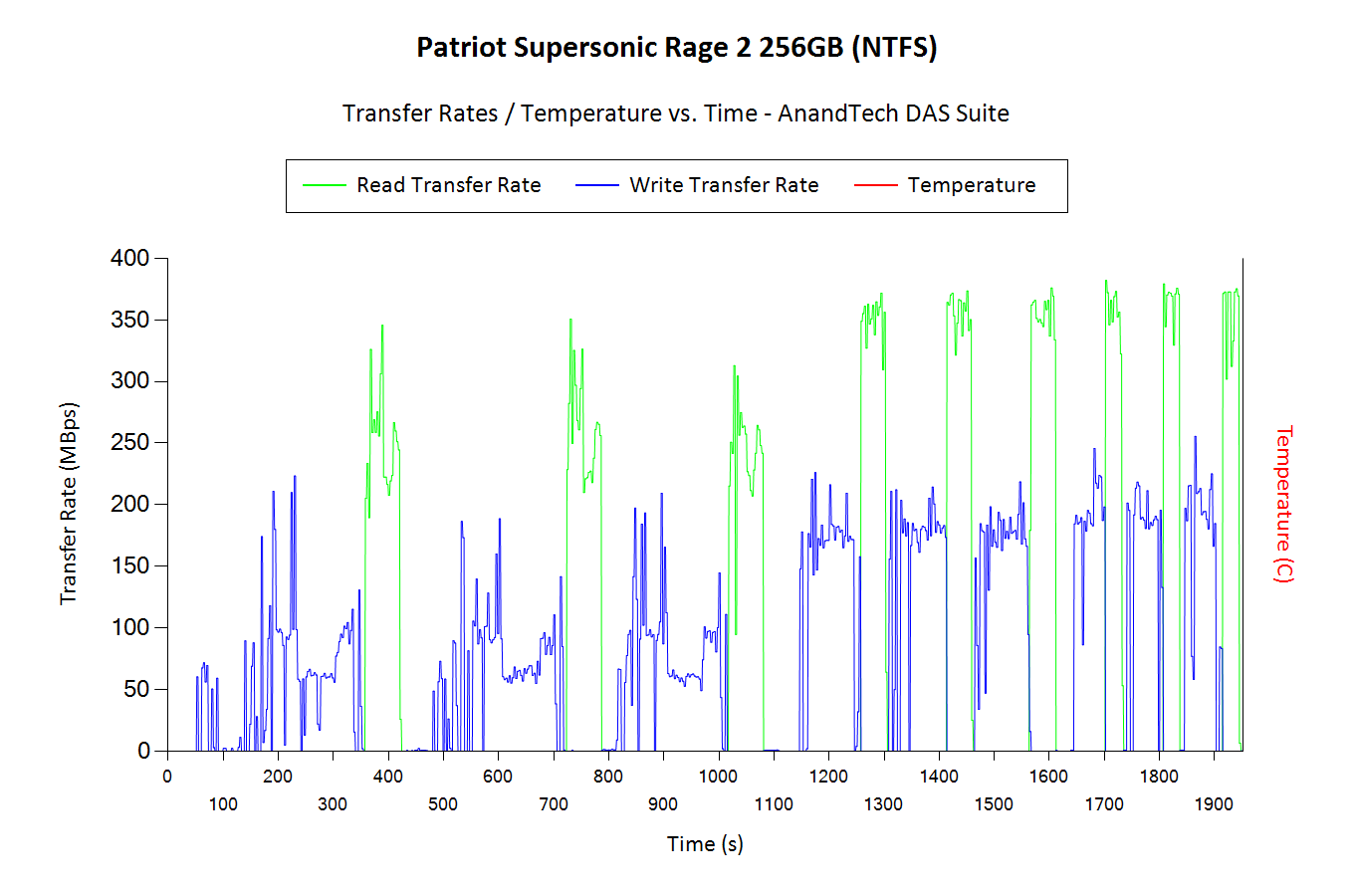
















Bookmarks